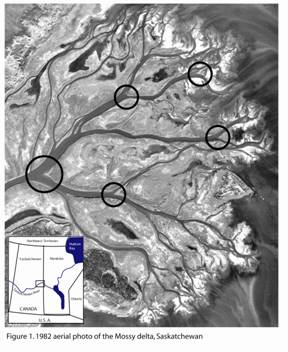

45382-AC8
A Field and Numerical Study of the Morphology, Flow, Sedimentary Processes, and Stability of River-Channel Bifurcations
This study consists of a field and numerical investigation of the morphology, flow, and sedimentary processes of natural river-channel bifurcations in order to understand and predict their dynamical behavior. During the reporting period a research team consisting of one geoscience graduate student, an undergraduate geoscience major, and the PI analyzed the field data we collected in the summer of 2007 on channel bifurcations of the Mossy Delta (Fig. 1) in the Cumberland marshes area of east-central Saskatchewan and conducted numerical experiments using Delft3D. The field data consist of bed and water surface topography, flow velocity, bathymetry, at each of eight bifurcations and over a large range of flow stages. In addition, sediment stratigraphy of a fossil bifurcation from 1947 was cored. Results (Edmonds and Slingerland 2008) show that over a range of channel aspect ratios, friction factors, and Shields numbers, we find three equilibrium functions relating the discharge ratio of the bifurcate arms at equilibrium to the Shields number. One function defines symmetrical configurations (equal partitioning of discharge), while the other two define asymmetrical configurations (unequal partitioning of discharge). Discharge asymmetries and morphologies of Mossy delta bifurcations are consistent with these predictions. Among the equilibrium bifurcations, only the asymmetrical type is stable to perturbations, such as a partial closing of one throat. This possibly explains why asymmetrical bifurcations are more common in nature.
